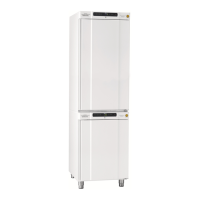3
b i o l ine
Example: Setting the upper limits for the alarms; LHL
Press and hold + until the display shows LAL
Press to select LAL, LHL is now shown in the display
Press to select LHL, 25 is shown in the display
Press or to set the desired value for the upper temperature limit
Press to conrm the set value
Press to return to LHL
Press to reach the next level, LLL
LHd, LLd, dA, dAd and bU are located on the same level
Press three times to leave the user menu
Menu Access +
[° C]
Display code and its message
Sensor for refrigeration system P-A Value on sensor for refrigeration system F1 Error on sensor for refrigeration system
Sensor for evaporator P-b Value for evaporator sensor F2 Error on evaporator sensor
Sensor for condensor P-C Value for condensor sensor F3 Error on condensor sensor
Sensor 2 for condensor P-d Value for condensor sensor 2 F4 Error on condensor sensor 2
Sensor for display and alarms P-E Value for display and alarm sensor F5 Error on sensor for display and alarm
Sensor for low-temperature
protection
P-F
Value for low-temperature protection
sensor
F6
Error on sensor for low-temperature
protection
An overheated condensor can be caused by a clogged condensor –
clean the condensor
F7 Overheated condensor
Open door indicator. Alarm [A1] will activate if the door is open longer
than alarm limits.
-0- Door open
Acknowledging an acoustic alarm
Alarm code A1: Press to acknowledge. Temperature alarm codes A2 and/or A3: Flashes in the display. Press to acknowledge. The
display will continue to ash if the temperature is outside the alarm limits.
Latching alarms: A2, A3, A4, A5
Due to the potential implications of alarms, the red danger triangle light will continue to remain on to warn the user of an alarm having
occured. Regardless of acknowleding, the light will remain on until an alarm history reset has been performed (holding and
for
more than 3 seconds), note that this will also reset temperature and alarm history.
Reading Max/Min temperature
Read the higest recorded temperature inside the cabinet by holding down . Read the lowest recorded temperature inside the cabinet
by holding down
.
Reading the alarm history – Example [A2]
[A2] ashes in the display – This means that the temperature has exceeded the set value for the upper temperature limit, LHL.Press
to acknowledge the [A2]. The display continues to ash, indicating that there is information in the alarm history. Press , Htt (High
temperature time) is shown, press
to see for how long the temperature was above the set alarm limit. Press to return to Htt.
Press
to reach Ht (Highest temperature). Press to read the highest recorded temperature during Htt. Press to return to Ht and
press again to leave the alarm history function. The procedure for reading an [A3] alarm is identical, apart from entering the alarm
history with the button. When reading out temperatures below set limits, the parameters are Ltt and Lt. A ashing display with no
alarm codes indicates that the alarm codes have been acknowledged, but the alarm system contains information.
Resetting Max/Min and alarm history
Resetting of the Max/Min and alarm history is done by holding and for more than 3 seconds, an acoustic signal will be given when
reset is complete.
Alarms
Alarm codes
A1 Door alarm
A2 The upper alarm limits, (LHL) is or has been activated
A3 The lower alarm limits, (LLL) alarm is or has been activated
Sensor read-out and error codes

